Analyzing Operational Efficiency: A Case Study of Finest Catch
VerifiedAdded on 2023/06/12
|7
|1910
|414
Report
AI Summary
This report analyzes the operational changes implemented at the Finest Catch restaurant, specifically the introduction of a combined counter and self-service model, and its subsequent impact on key performance objectives, namely speed and quality. The report discusses how these changes have positively influenced the quality of service and reduced customer wait times. It further applies the principles of throughput time and throughput rate, emphasizing their importance in restaurant management for optimizing efficiency and cost-effectiveness. The analysis evaluates how the changes have enhanced both the efficiency and effectiveness of the restaurant's operations, leading to improved customer satisfaction and overall performance. The report concludes that effective operation management, as demonstrated by the Finest Catch, is crucial for organizational success and growth.

Entrepreneurial
Ventures and Mind-
set
Ventures and Mind-
set
Secure Best Marks with AI Grader
Need help grading? Try our AI Grader for instant feedback on your assignments.
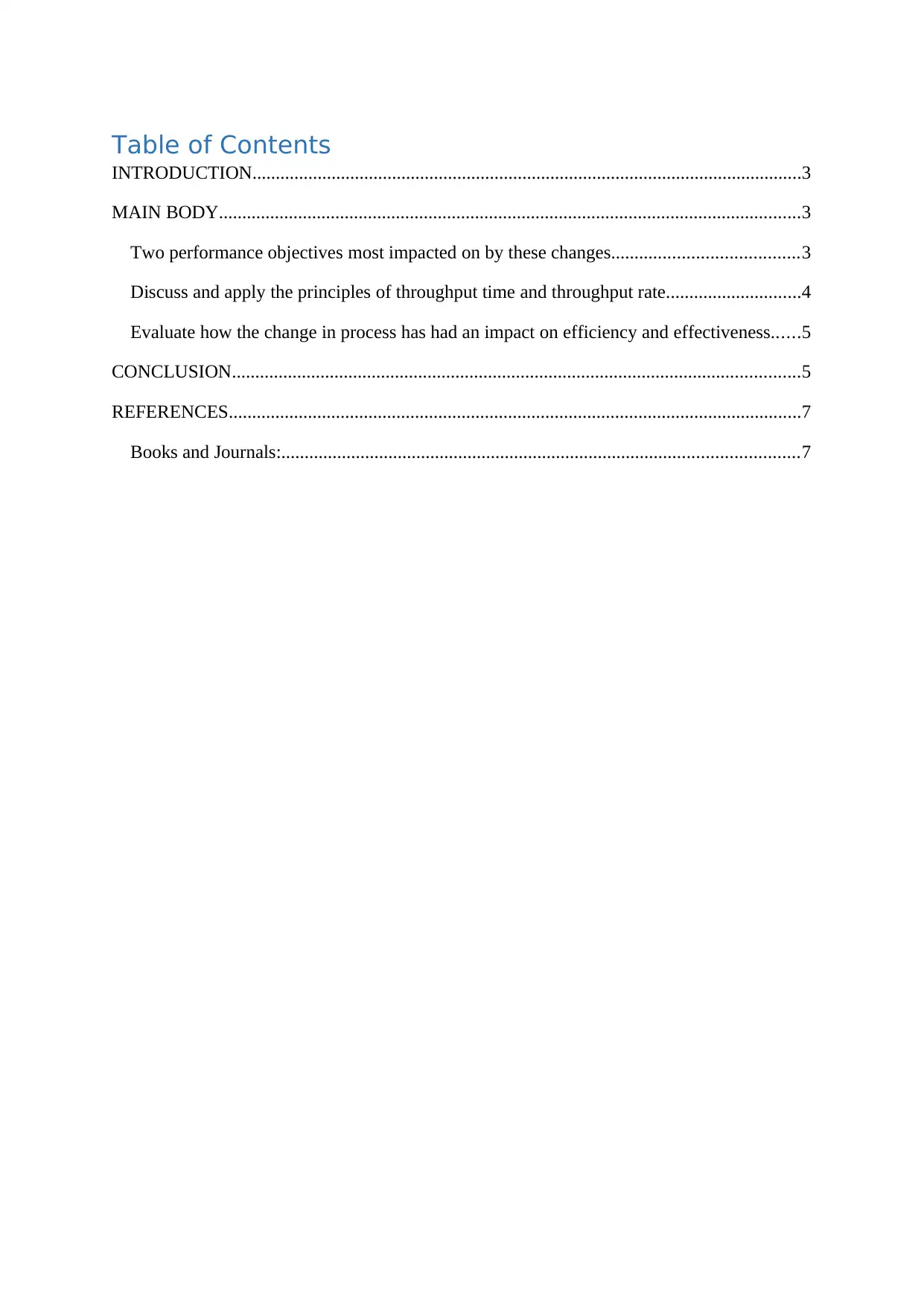
Table of Contents
INTRODUCTION......................................................................................................................3
MAIN BODY.............................................................................................................................3
Two performance objectives most impacted on by these changes........................................3
Discuss and apply the principles of throughput time and throughput rate.............................4
Evaluate how the change in process has had an impact on efficiency and effectiveness......5
CONCLUSION..........................................................................................................................5
REFERENCES...........................................................................................................................7
Books and Journals:...............................................................................................................7
INTRODUCTION......................................................................................................................3
MAIN BODY.............................................................................................................................3
Two performance objectives most impacted on by these changes........................................3
Discuss and apply the principles of throughput time and throughput rate.............................4
Evaluate how the change in process has had an impact on efficiency and effectiveness......5
CONCLUSION..........................................................................................................................5
REFERENCES...........................................................................................................................7
Books and Journals:...............................................................................................................7
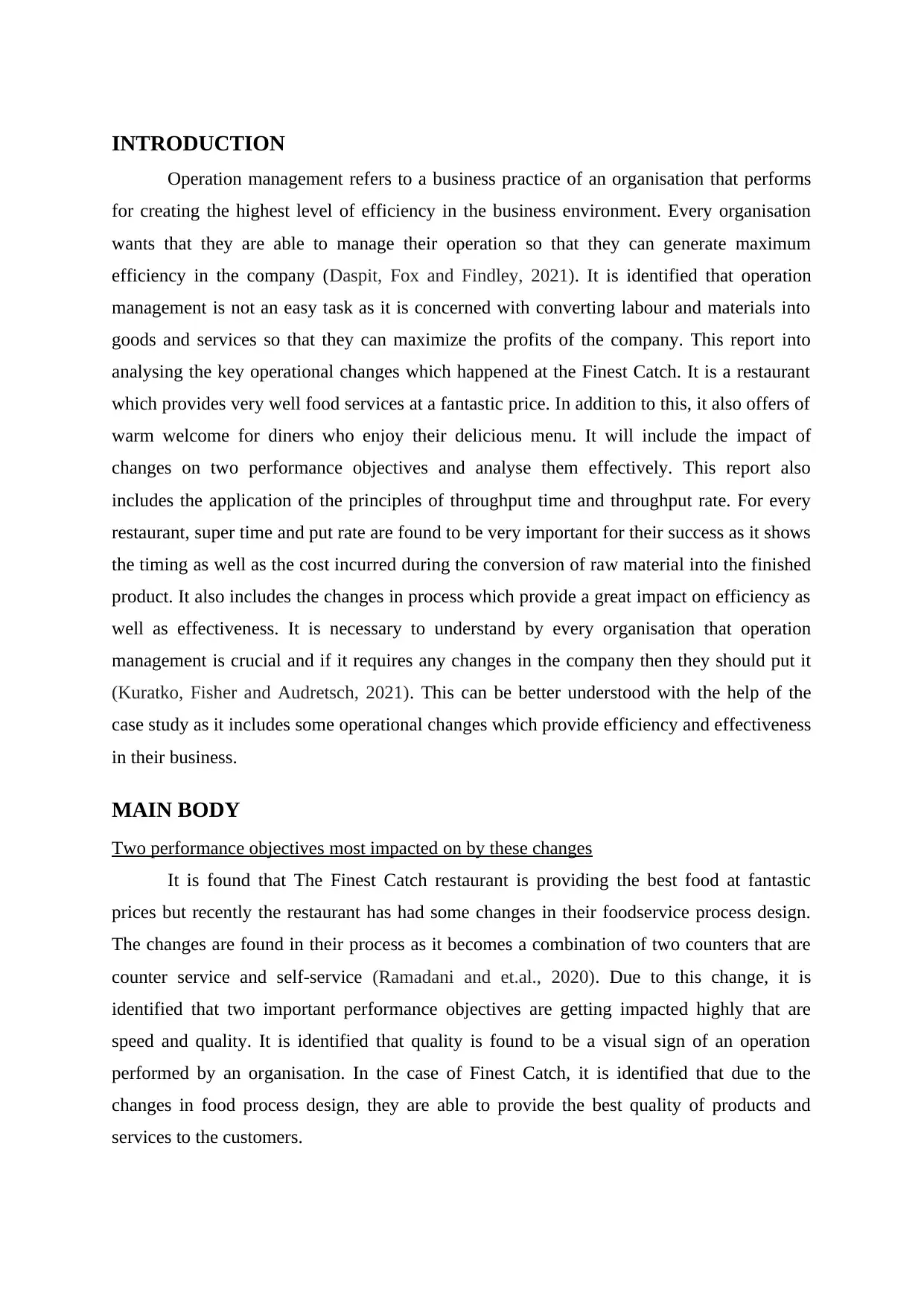
INTRODUCTION
Operation management refers to a business practice of an organisation that performs
for creating the highest level of efficiency in the business environment. Every organisation
wants that they are able to manage their operation so that they can generate maximum
efficiency in the company (Daspit, Fox and Findley, 2021). It is identified that operation
management is not an easy task as it is concerned with converting labour and materials into
goods and services so that they can maximize the profits of the company. This report into
analysing the key operational changes which happened at the Finest Catch. It is a restaurant
which provides very well food services at a fantastic price. In addition to this, it also offers of
warm welcome for diners who enjoy their delicious menu. It will include the impact of
changes on two performance objectives and analyse them effectively. This report also
includes the application of the principles of throughput time and throughput rate. For every
restaurant, super time and put rate are found to be very important for their success as it shows
the timing as well as the cost incurred during the conversion of raw material into the finished
product. It also includes the changes in process which provide a great impact on efficiency as
well as effectiveness. It is necessary to understand by every organisation that operation
management is crucial and if it requires any changes in the company then they should put it
(Kuratko, Fisher and Audretsch, 2021). This can be better understood with the help of the
case study as it includes some operational changes which provide efficiency and effectiveness
in their business.
MAIN BODY
Two performance objectives most impacted on by these changes
It is found that The Finest Catch restaurant is providing the best food at fantastic
prices but recently the restaurant has had some changes in their foodservice process design.
The changes are found in their process as it becomes a combination of two counters that are
counter service and self-service (Ramadani and et.al., 2020). Due to this change, it is
identified that two important performance objectives are getting impacted highly that are
speed and quality. It is identified that quality is found to be a visual sign of an operation
performed by an organisation. In the case of Finest Catch, it is identified that due to the
changes in food process design, they are able to provide the best quality of products and
services to the customers.
Operation management refers to a business practice of an organisation that performs
for creating the highest level of efficiency in the business environment. Every organisation
wants that they are able to manage their operation so that they can generate maximum
efficiency in the company (Daspit, Fox and Findley, 2021). It is identified that operation
management is not an easy task as it is concerned with converting labour and materials into
goods and services so that they can maximize the profits of the company. This report into
analysing the key operational changes which happened at the Finest Catch. It is a restaurant
which provides very well food services at a fantastic price. In addition to this, it also offers of
warm welcome for diners who enjoy their delicious menu. It will include the impact of
changes on two performance objectives and analyse them effectively. This report also
includes the application of the principles of throughput time and throughput rate. For every
restaurant, super time and put rate are found to be very important for their success as it shows
the timing as well as the cost incurred during the conversion of raw material into the finished
product. It also includes the changes in process which provide a great impact on efficiency as
well as effectiveness. It is necessary to understand by every organisation that operation
management is crucial and if it requires any changes in the company then they should put it
(Kuratko, Fisher and Audretsch, 2021). This can be better understood with the help of the
case study as it includes some operational changes which provide efficiency and effectiveness
in their business.
MAIN BODY
Two performance objectives most impacted on by these changes
It is found that The Finest Catch restaurant is providing the best food at fantastic
prices but recently the restaurant has had some changes in their foodservice process design.
The changes are found in their process as it becomes a combination of two counters that are
counter service and self-service (Ramadani and et.al., 2020). Due to this change, it is
identified that two important performance objectives are getting impacted highly that are
speed and quality. It is identified that quality is found to be a visual sign of an operation
performed by an organisation. In the case of Finest Catch, it is identified that due to the
changes in food process design, they are able to provide the best quality of products and
services to the customers.
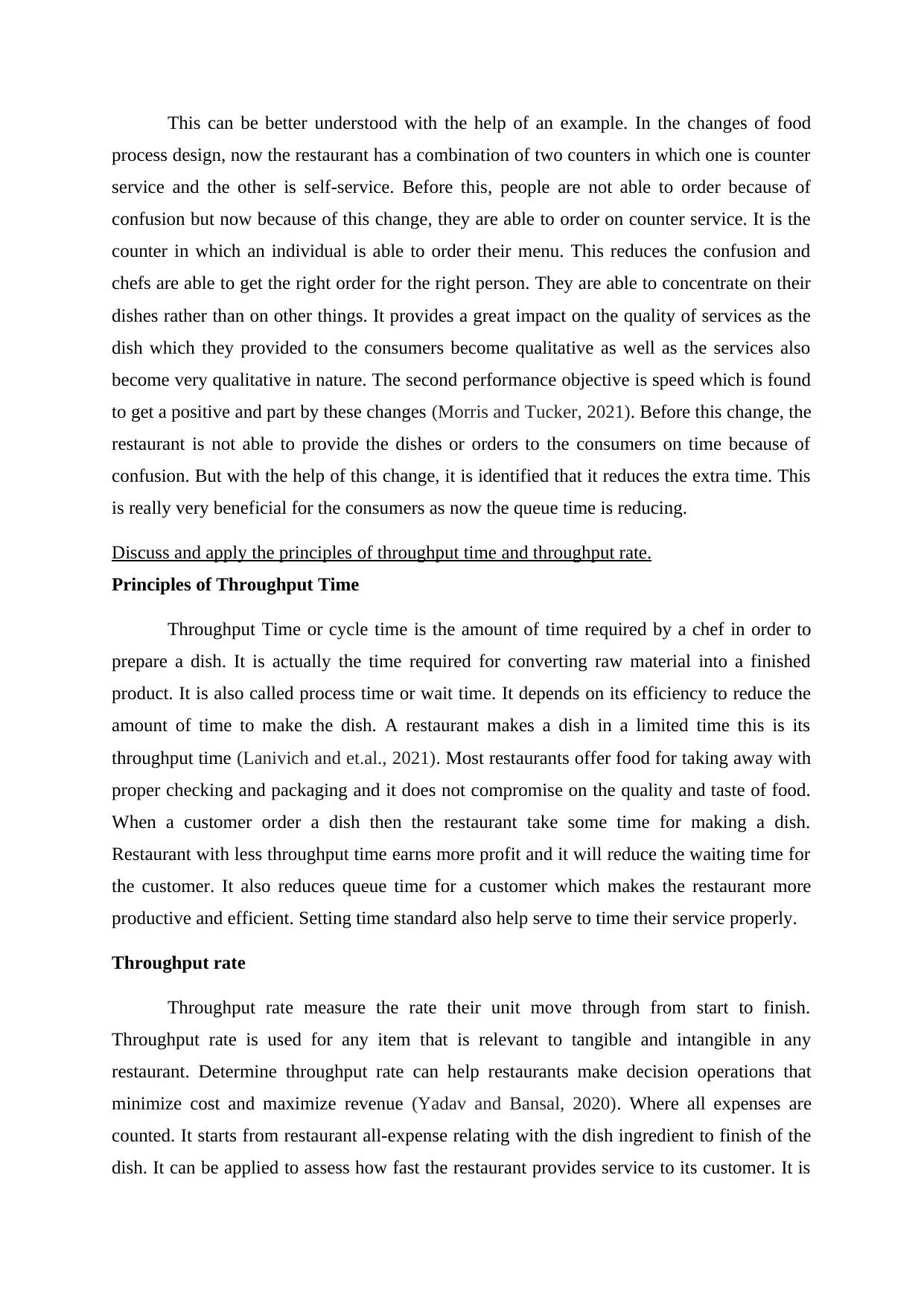
This can be better understood with the help of an example. In the changes of food
process design, now the restaurant has a combination of two counters in which one is counter
service and the other is self-service. Before this, people are not able to order because of
confusion but now because of this change, they are able to order on counter service. It is the
counter in which an individual is able to order their menu. This reduces the confusion and
chefs are able to get the right order for the right person. They are able to concentrate on their
dishes rather than on other things. It provides a great impact on the quality of services as the
dish which they provided to the consumers become qualitative as well as the services also
become very qualitative in nature. The second performance objective is speed which is found
to get a positive and part by these changes (Morris and Tucker, 2021). Before this change, the
restaurant is not able to provide the dishes or orders to the consumers on time because of
confusion. But with the help of this change, it is identified that it reduces the extra time. This
is really very beneficial for the consumers as now the queue time is reducing.
Discuss and apply the principles of throughput time and throughput rate.
Principles of Throughput Time
Throughput Time or cycle time is the amount of time required by a chef in order to
prepare a dish. It is actually the time required for converting raw material into a finished
product. It is also called process time or wait time. It depends on its efficiency to reduce the
amount of time to make the dish. A restaurant makes a dish in a limited time this is its
throughput time (Lanivich and et.al., 2021). Most restaurants offer food for taking away with
proper checking and packaging and it does not compromise on the quality and taste of food.
When a customer order a dish then the restaurant take some time for making a dish.
Restaurant with less throughput time earns more profit and it will reduce the waiting time for
the customer. It also reduces queue time for a customer which makes the restaurant more
productive and efficient. Setting time standard also help serve to time their service properly.
Throughput rate
Throughput rate measure the rate their unit move through from start to finish.
Throughput rate is used for any item that is relevant to tangible and intangible in any
restaurant. Determine throughput rate can help restaurants make decision operations that
minimize cost and maximize revenue (Yadav and Bansal, 2020). Where all expenses are
counted. It starts from restaurant all-expense relating with the dish ingredient to finish of the
dish. It can be applied to assess how fast the restaurant provides service to its customer. It is
process design, now the restaurant has a combination of two counters in which one is counter
service and the other is self-service. Before this, people are not able to order because of
confusion but now because of this change, they are able to order on counter service. It is the
counter in which an individual is able to order their menu. This reduces the confusion and
chefs are able to get the right order for the right person. They are able to concentrate on their
dishes rather than on other things. It provides a great impact on the quality of services as the
dish which they provided to the consumers become qualitative as well as the services also
become very qualitative in nature. The second performance objective is speed which is found
to get a positive and part by these changes (Morris and Tucker, 2021). Before this change, the
restaurant is not able to provide the dishes or orders to the consumers on time because of
confusion. But with the help of this change, it is identified that it reduces the extra time. This
is really very beneficial for the consumers as now the queue time is reducing.
Discuss and apply the principles of throughput time and throughput rate.
Principles of Throughput Time
Throughput Time or cycle time is the amount of time required by a chef in order to
prepare a dish. It is actually the time required for converting raw material into a finished
product. It is also called process time or wait time. It depends on its efficiency to reduce the
amount of time to make the dish. A restaurant makes a dish in a limited time this is its
throughput time (Lanivich and et.al., 2021). Most restaurants offer food for taking away with
proper checking and packaging and it does not compromise on the quality and taste of food.
When a customer order a dish then the restaurant take some time for making a dish.
Restaurant with less throughput time earns more profit and it will reduce the waiting time for
the customer. It also reduces queue time for a customer which makes the restaurant more
productive and efficient. Setting time standard also help serve to time their service properly.
Throughput rate
Throughput rate measure the rate their unit move through from start to finish.
Throughput rate is used for any item that is relevant to tangible and intangible in any
restaurant. Determine throughput rate can help restaurants make decision operations that
minimize cost and maximize revenue (Yadav and Bansal, 2020). Where all expenses are
counted. It starts from restaurant all-expense relating with the dish ingredient to finish of the
dish. It can be applied to assess how fast the restaurant provides service to its customer. It is
Secure Best Marks with AI Grader
Need help grading? Try our AI Grader for instant feedback on your assignments.
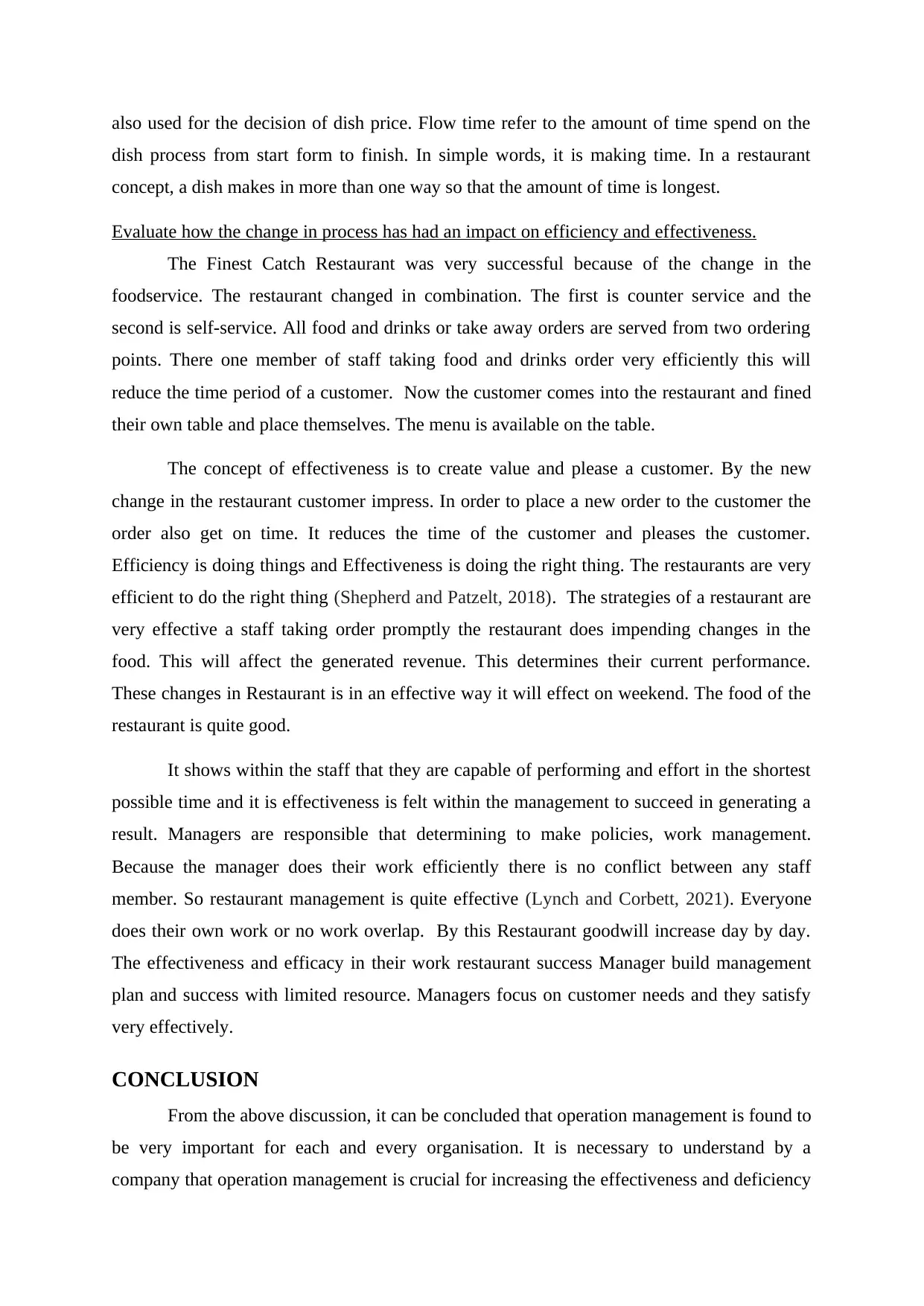
also used for the decision of dish price. Flow time refer to the amount of time spend on the
dish process from start form to finish. In simple words, it is making time. In a restaurant
concept, a dish makes in more than one way so that the amount of time is longest.
Evaluate how the change in process has had an impact on efficiency and effectiveness.
The Finest Catch Restaurant was very successful because of the change in the
foodservice. The restaurant changed in combination. The first is counter service and the
second is self-service. All food and drinks or take away orders are served from two ordering
points. There one member of staff taking food and drinks order very efficiently this will
reduce the time period of a customer. Now the customer comes into the restaurant and fined
their own table and place themselves. The menu is available on the table.
The concept of effectiveness is to create value and please a customer. By the new
change in the restaurant customer impress. In order to place a new order to the customer the
order also get on time. It reduces the time of the customer and pleases the customer.
Efficiency is doing things and Effectiveness is doing the right thing. The restaurants are very
efficient to do the right thing (Shepherd and Patzelt, 2018). The strategies of a restaurant are
very effective a staff taking order promptly the restaurant does impending changes in the
food. This will affect the generated revenue. This determines their current performance.
These changes in Restaurant is in an effective way it will effect on weekend. The food of the
restaurant is quite good.
It shows within the staff that they are capable of performing and effort in the shortest
possible time and it is effectiveness is felt within the management to succeed in generating a
result. Managers are responsible that determining to make policies, work management.
Because the manager does their work efficiently there is no conflict between any staff
member. So restaurant management is quite effective (Lynch and Corbett, 2021). Everyone
does their own work or no work overlap. By this Restaurant goodwill increase day by day.
The effectiveness and efficacy in their work restaurant success Manager build management
plan and success with limited resource. Managers focus on customer needs and they satisfy
very effectively.
CONCLUSION
From the above discussion, it can be concluded that operation management is found to
be very important for each and every organisation. It is necessary to understand by a
company that operation management is crucial for increasing the effectiveness and deficiency
dish process from start form to finish. In simple words, it is making time. In a restaurant
concept, a dish makes in more than one way so that the amount of time is longest.
Evaluate how the change in process has had an impact on efficiency and effectiveness.
The Finest Catch Restaurant was very successful because of the change in the
foodservice. The restaurant changed in combination. The first is counter service and the
second is self-service. All food and drinks or take away orders are served from two ordering
points. There one member of staff taking food and drinks order very efficiently this will
reduce the time period of a customer. Now the customer comes into the restaurant and fined
their own table and place themselves. The menu is available on the table.
The concept of effectiveness is to create value and please a customer. By the new
change in the restaurant customer impress. In order to place a new order to the customer the
order also get on time. It reduces the time of the customer and pleases the customer.
Efficiency is doing things and Effectiveness is doing the right thing. The restaurants are very
efficient to do the right thing (Shepherd and Patzelt, 2018). The strategies of a restaurant are
very effective a staff taking order promptly the restaurant does impending changes in the
food. This will affect the generated revenue. This determines their current performance.
These changes in Restaurant is in an effective way it will effect on weekend. The food of the
restaurant is quite good.
It shows within the staff that they are capable of performing and effort in the shortest
possible time and it is effectiveness is felt within the management to succeed in generating a
result. Managers are responsible that determining to make policies, work management.
Because the manager does their work efficiently there is no conflict between any staff
member. So restaurant management is quite effective (Lynch and Corbett, 2021). Everyone
does their own work or no work overlap. By this Restaurant goodwill increase day by day.
The effectiveness and efficacy in their work restaurant success Manager build management
plan and success with limited resource. Managers focus on customer needs and they satisfy
very effectively.
CONCLUSION
From the above discussion, it can be concluded that operation management is found to
be very important for each and every organisation. It is necessary to understand by a
company that operation management is crucial for increasing the effectiveness and deficiency
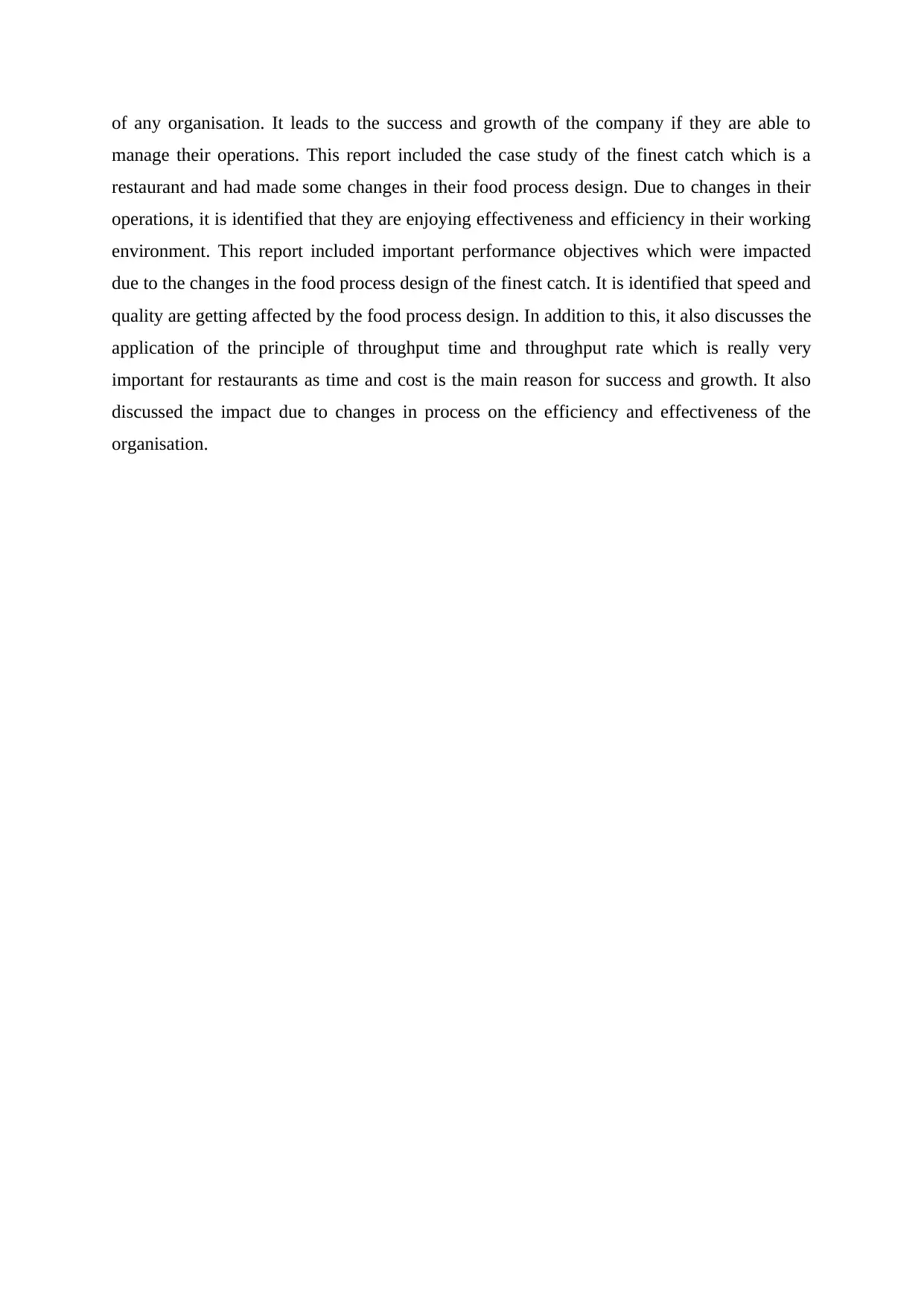
of any organisation. It leads to the success and growth of the company if they are able to
manage their operations. This report included the case study of the finest catch which is a
restaurant and had made some changes in their food process design. Due to changes in their
operations, it is identified that they are enjoying effectiveness and efficiency in their working
environment. This report included important performance objectives which were impacted
due to the changes in the food process design of the finest catch. It is identified that speed and
quality are getting affected by the food process design. In addition to this, it also discusses the
application of the principle of throughput time and throughput rate which is really very
important for restaurants as time and cost is the main reason for success and growth. It also
discussed the impact due to changes in process on the efficiency and effectiveness of the
organisation.
manage their operations. This report included the case study of the finest catch which is a
restaurant and had made some changes in their food process design. Due to changes in their
operations, it is identified that they are enjoying effectiveness and efficiency in their working
environment. This report included important performance objectives which were impacted
due to the changes in the food process design of the finest catch. It is identified that speed and
quality are getting affected by the food process design. In addition to this, it also discusses the
application of the principle of throughput time and throughput rate which is really very
important for restaurants as time and cost is the main reason for success and growth. It also
discussed the impact due to changes in process on the efficiency and effectiveness of the
organisation.
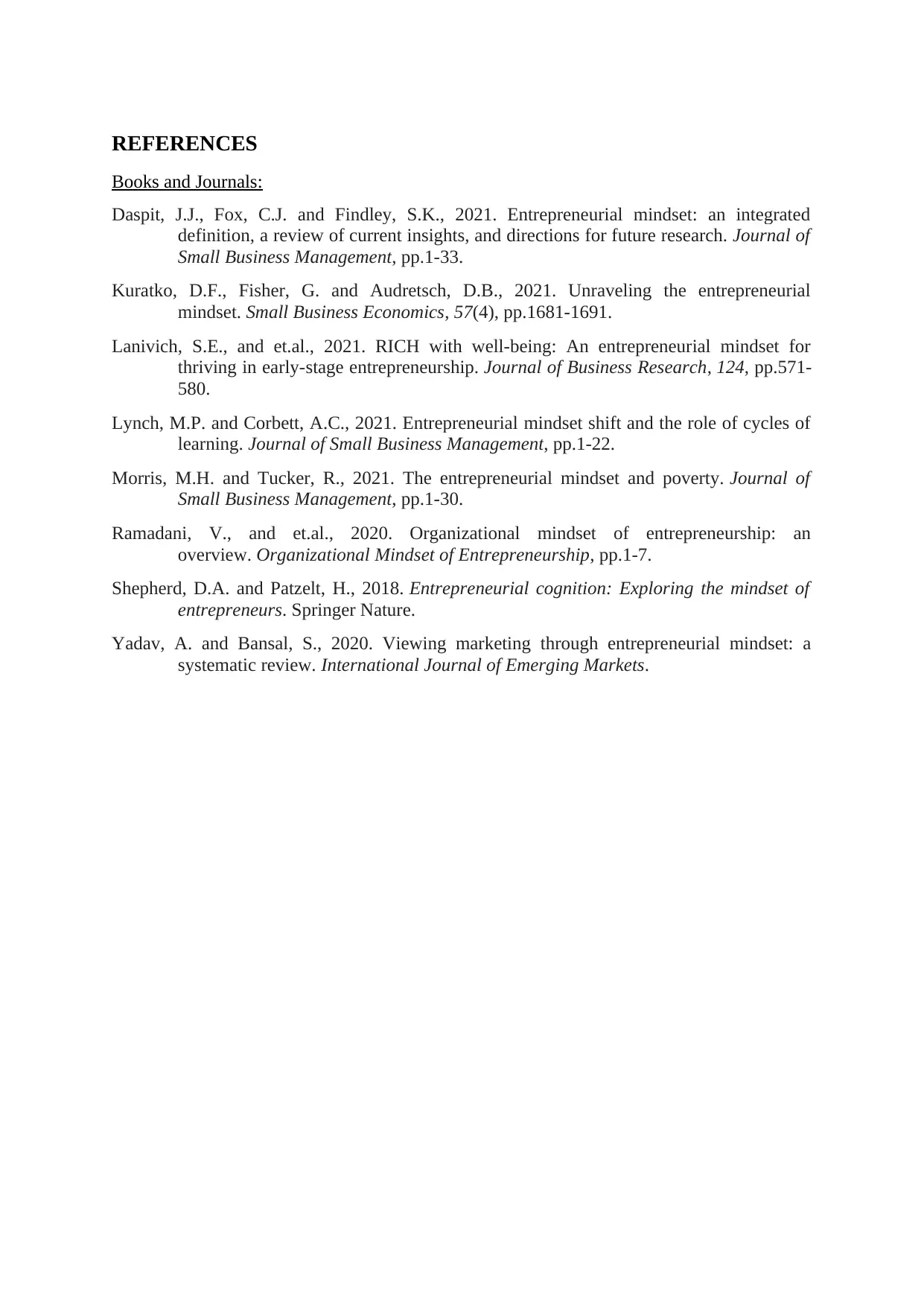
REFERENCES
Books and Journals:
Daspit, J.J., Fox, C.J. and Findley, S.K., 2021. Entrepreneurial mindset: an integrated
definition, a review of current insights, and directions for future research. Journal of
Small Business Management, pp.1-33.
Kuratko, D.F., Fisher, G. and Audretsch, D.B., 2021. Unraveling the entrepreneurial
mindset. Small Business Economics, 57(4), pp.1681-1691.
Lanivich, S.E., and et.al., 2021. RICH with well-being: An entrepreneurial mindset for
thriving in early-stage entrepreneurship. Journal of Business Research, 124, pp.571-
580.
Lynch, M.P. and Corbett, A.C., 2021. Entrepreneurial mindset shift and the role of cycles of
learning. Journal of Small Business Management, pp.1-22.
Morris, M.H. and Tucker, R., 2021. The entrepreneurial mindset and poverty. Journal of
Small Business Management, pp.1-30.
Ramadani, V., and et.al., 2020. Organizational mindset of entrepreneurship: an
overview. Organizational Mindset of Entrepreneurship, pp.1-7.
Shepherd, D.A. and Patzelt, H., 2018. Entrepreneurial cognition: Exploring the mindset of
entrepreneurs. Springer Nature.
Yadav, A. and Bansal, S., 2020. Viewing marketing through entrepreneurial mindset: a
systematic review. International Journal of Emerging Markets.
Books and Journals:
Daspit, J.J., Fox, C.J. and Findley, S.K., 2021. Entrepreneurial mindset: an integrated
definition, a review of current insights, and directions for future research. Journal of
Small Business Management, pp.1-33.
Kuratko, D.F., Fisher, G. and Audretsch, D.B., 2021. Unraveling the entrepreneurial
mindset. Small Business Economics, 57(4), pp.1681-1691.
Lanivich, S.E., and et.al., 2021. RICH with well-being: An entrepreneurial mindset for
thriving in early-stage entrepreneurship. Journal of Business Research, 124, pp.571-
580.
Lynch, M.P. and Corbett, A.C., 2021. Entrepreneurial mindset shift and the role of cycles of
learning. Journal of Small Business Management, pp.1-22.
Morris, M.H. and Tucker, R., 2021. The entrepreneurial mindset and poverty. Journal of
Small Business Management, pp.1-30.
Ramadani, V., and et.al., 2020. Organizational mindset of entrepreneurship: an
overview. Organizational Mindset of Entrepreneurship, pp.1-7.
Shepherd, D.A. and Patzelt, H., 2018. Entrepreneurial cognition: Exploring the mindset of
entrepreneurs. Springer Nature.
Yadav, A. and Bansal, S., 2020. Viewing marketing through entrepreneurial mindset: a
systematic review. International Journal of Emerging Markets.
1 out of 7
Related Documents
Your All-in-One AI-Powered Toolkit for Academic Success.
+13062052269
info@desklib.com
Available 24*7 on WhatsApp / Email
![[object Object]](/_next/static/media/star-bottom.7253800d.svg)
Unlock your academic potential
© 2024 | Zucol Services PVT LTD | All rights reserved.




